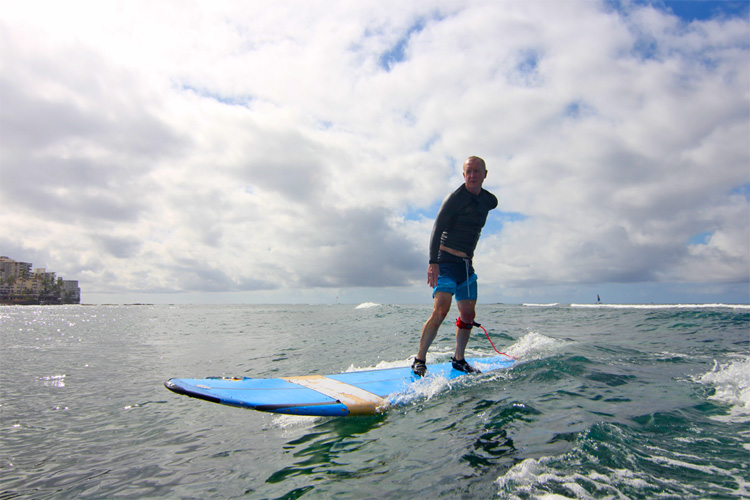This is the story of how Steve Brown reconnected with surfing, lost an arm, and returned to the surf zone for an emotional comeback. This is his diary. This is a dream come true.
In 1973, during a college overseas study trip to Indonesia, Steve had a chance to spend some time at Kuta Beach, Bali, bodysurfing, watching the surfers from Australia, and contemplating the meaning of life.
One day, he rented what turned out to be a very water-logged surfboard and tried to surf. Steve loved the experience, but time passed by quickly.
In 2002, he started traveling to Southern California on a regular basis for a business selling carbon fiber molding compounds.
Although he was busy with family, work, and racing bicycles, he kept seeing advertisements for surfing lessons and postponing them till the next summer.
Steve always wanted to try it again. Two years ago, during a business meeting in Santa Ana, California, he mentioned his interest in taking surfing lessons that summer to an engineer.
The engineer told Steve he was a surfer and would take him out.
In October 2016, Steve Brown lost his left arm to cancer.
When he got back on the surfboard in January 2017 and was able to ride a wave once again, it became a story.
"Originally, I wanted to have it written prior to surgery for amputation. It would be a Christmas present for friends and family who had been so supportive and essential to my recovery during a difficult time and the two previous arm reconstructions," explains Brown, 64, a businessman from Portland, Oregon.
"And it would also be a thank you to all the people who welcomed me into surfing; in a non-religious way, it has been a blessing."
Steve Brown decided to share his story with the SurferToday readers. Hopefully, it will inspire us to get back to surfing every time we feel sad, down, or angry with life.
July 2015 | Dawn Patrol
I am driving at 5 am to Huntington Beach with a new wetsuit, a towel, excitement, and dread. Learning to surf has been a lifelong goal; however, when you are 63 years old, you understand danger and stupid things.
Two hours later, Bob Vale hands me an 8' funboard. His friend Randy and I walk toward the water at 8th St, near the lifeguard tower, just north of the pier.
Right before we paddle out, Randy asks if I know how to duck dive and turtle roll. Even though I know what he means, the actual mechanics with the board will be a surprise.
Somehow, after getting pummeled in the shore break and impact zone, I made it out beyond the break and sat up. My strength is gone, and I am done for the day.
Just sitting on the board and being out there was one of the most satisfying things I had ever done, and I have not even tried to catch a wave.
Recovering a bit, I let the waves and my best body surfing skills push me back to shore. I sit on the beach and watch Bob and Randy surf for an hour.
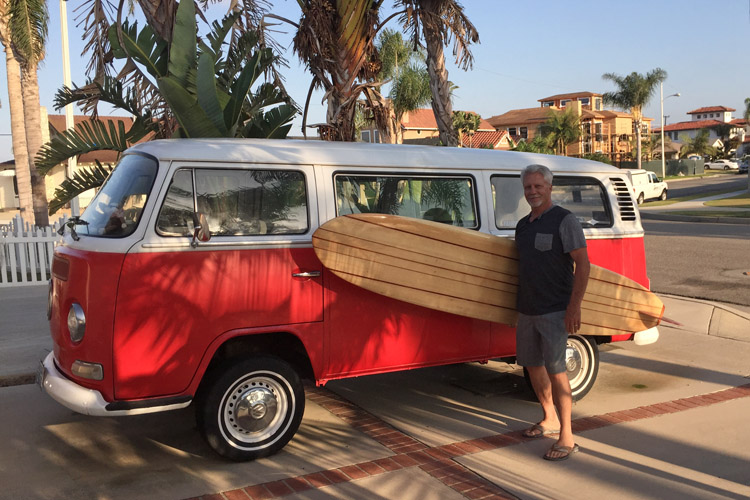
August 2015 | Back to the Surf
A month later, I am swimming three days a week, doing core exercises, and watching "how to pop up" videos on the web. This time, I will be ready.
I follow Bob through the shore break but lose pace in the impact zone. The Huntington Beach break, north of the pier, has a nasty rip, and I can't break through.
I have drifted to the 12th St lifeguard tower; I paddle in, walk back to where I and begin again. Four times I try with the same result. Trying to catch waves in the shore break only tosses me around.
One wave takes the board and drags me by the leash. The first rule of surfing is "Don't panic." Three seconds become five. Relaxing and thinking about the problem, my head clears the surface and I am pulling in on the leash.
I do not get outside beyond the main break, but I still have a great time. It was one of those life-affirming experiences. Rinsing with warm water from the large plastic ex-detergent container, wrapped in a towel for insulation, I change into my white shirt and suit on Highway One.
I drive to my first meeting of the day. I am hooked.
September 2015 | Take Three
For the next two months, I took lessons, swam longer and harder in the pool, and did endless pop-ups in my basement. I have two wonderful instructors, but struggle to stand up.
Every time I feel the push of the wave, things go too fast, my mind goes blank, and my body will not respond.
But in September, on a warm sunny morning with no wind, on my last attempt in the foam, I stand up.
I have competed and won many athletic events my whole life. During the past ten years as a master track cyclist, I bettered a handful of national champions, and being part of the 23 million people who surf is as satisfying as any of those things.
Driving north, looking at the ocean, all I can think about is getting in the water again. Two weeks later, I am back in the foam, stand up on the first try, and begin to turn a bit.
By the end of the session, I am ready to merge my new talent with the paddling prowess from the Huntington Beach Pier to catch an open wave face.
November 2015 | Dropping In
The next HB State Park lesson is a disaster. Carrying my new 8' foamy, I shuffle in the shallow water to avoid jellyfish stings and paddle out into waves that are waist to chest-high.
It's way too much wave and speed for my foamy and me. Every time I felt the push and the speed, I buried the nose. Twenty minutes into the lesson, my instructor hurt his back.
Bigger waves are building outside, and more locals are making it a larger gathering on a beautiful November day. I am in the middle of California surf heaven.
Staying inside, I try to catch something small. Looking over my right shoulder, I see a clean wave after it has passed all the other surfers.
As a goofy footer, I know the nice left break is for me. I paddle to make the wave. Another failure, but this time, my instructor is screaming at me to come in. He is livid.
Although I was inside, away from the others, and saw what was a clean wave, a young woman had caught the next wave and was heading my way after I had turned to paddle.
She saw me and cut her ride short. Knowing to be careful, stay out of the way of others, and be polite, I thought I had done my best to observe surfing etiquette. I was not happy.
The woman was cool and never said a word. I felt bad, as I had cut her ride short. But I was really pissed at getting yelled at by an instructor who was blaming me. My last surf trip of the summer, and I had zero.
Back in the pool, adding distance and intensity, I was learning to be a swimmer, doing 40-50 pop-ups four times a week. And visiting Surfline to keep up-to-date with conditions.
January 2016 | Goleta
At a fundraising dinner, I am seated next to a woman whose brother is a boatbuilder and shaper in Goleta, California. Ironically, it is on the way to a meeting in Santa Maria I have next week.
My confidence is broken, but I still think I might be a surfer someday. I sent him an email, and he agreed to meet.
I can paddle a bit, sit up on a board outside, and almost find a wave; I can't catch an open wave, and here I am visiting a shaper at his shop. How deeply would I be drawn in if I could actually surf?
January 2016 | Imagination
My breakthrough comes in a strange way.
One morning, I find a new tumor on my arm. Eighteen months after major surgery, where I lost my left biceps at the first head, had my first skin graft, and a second course of radiation, cancer is back.
There may not be enough real estate left in my arm for another surgery short of amputation.
My imagination goes in two directions. With one arm, my life as an athlete is done, and my other hobbies are also trashed. The other thought is how to try to surf again before surgery.
Mexico or Hawaii? I search.
Cabo San Lucas looks good, close enough, and affordable - a hotel with a surf school and a beach. My wife balks. Waikiki, why not? A good friend has a condo we can have for free when it is not rented.
What if we go to Honolulu to see if we even like it? "Deal," she says. If the surfing works, we have a new place to play. In two hours, I have booked a flight, reserved a room, and found a surf school across the street from the hotel.
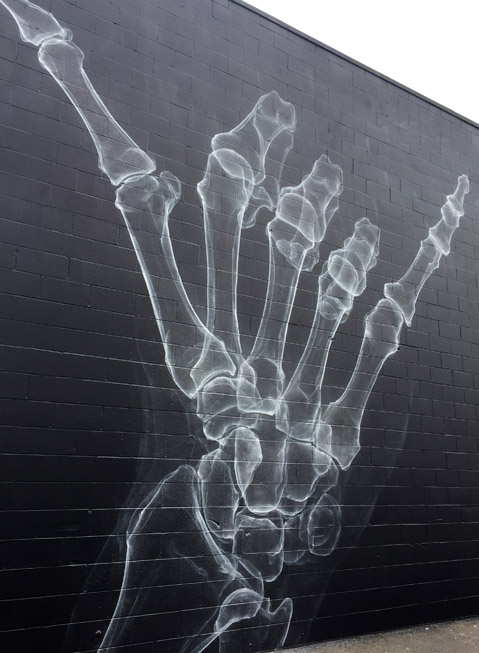
January 2016 | Waikiki, Hawaii
Four weeks later, I am in Waikiki at a private lesson, off the little beach near the Natatorium with Kai Sallas' Pro Surf School.
First wave: I am up riding the giant surf school board. But who does not surf at Waikiki? It is also the first day of the Quiksilver In Memory Of Eddie Aikau in Waimea Bay. Anyone who surfs is talking about the big waves up North. The television is running an endless loop of every ride, and I get a quick lesson about Eddie Aikau.
Ready to have fun on day two, I am told I will be going out with the shop owner, Kai Salas, one of the best longboarders in the world.
Before we head out, I show him my now perfect to my feet SoCal pop-up. He tells me I am now going to learn the Island style - pop-up low, stabilize, and then surf.
We head out to a local break known as Tonggs. We stay inside with a knee-high wave. I catch on the first try, surfing low, with arms to each side. My only problem is getting hypnotized by the long ride, which necessitates a long paddle back to Kai.
With my head full of Quiksilver images and riding waves with Kai, I am totally stoked for day three. To my surprise, I learn I am going out with him again the next day.
We paddle to the same inside break at Tonggs, but there is no wave. I am just happy to be on the water, but Kai hears the meter ticking.
He points to a break that seems much further out toward Diamond Head, where a waist-to-chest-high wave is breaking.
Trusting my ability to somewhat paddle, we make it just outside the break with half a dozen locals. They know and respect Kai, so it is cool. I receive clear instructions: after I catch a wave, get out of the channel as fast as possible, paddle back outside away from everyone, and be ready to come in when signaled.
I catch a few waves, fall a couple of times early, and make sure to thank everyone for letting me there. The long paddle back is wearing me out. I am hoping we are at the end of the lesson.
After a lull, Kai tells me to turn around and paddle. "paddle fast, stand up." I am gone. Remembering not to get in too far, I drop to the board, get out of the channel, and start my paddle back.
Kai signals me in as he and a friend are smiling. They told me I disappeared behind the wave, and a bit later, they saw my head, and I was standing up.
They were very pleased that I caught and rode down the face of a decent wave. I catch the next small wave, ride it long and far, then paddle to shore pushed by the foam.
Four weeks later, I leave the orthopedic oncologist's office with a date for surgery. It takes less than a minute to calculate; I can fit in another trip to Waikiki before surgery.
Six weeks, and my wife and I are sitting in a hotel at the end of Waikiki with a view of the ocean and Diamond Head.
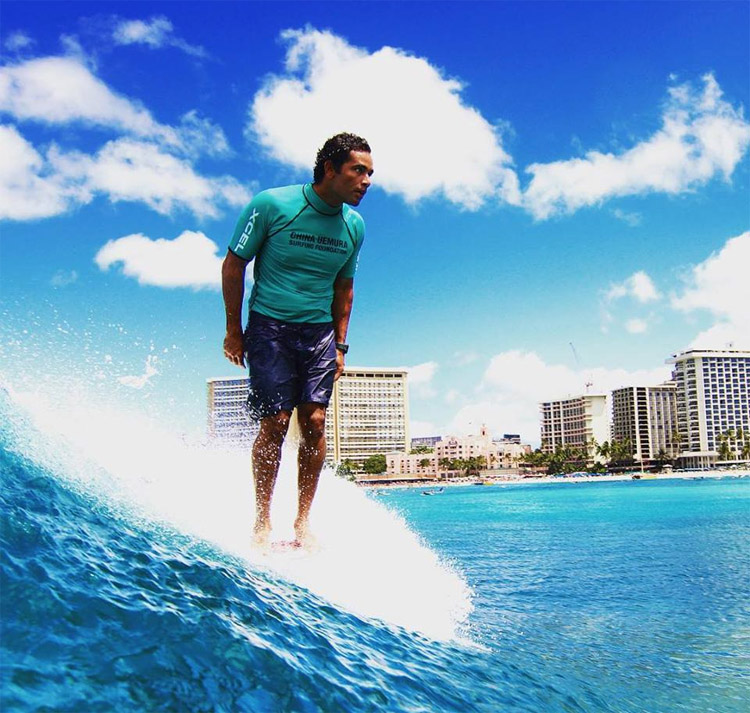
January 2016 | The Diamond Head Session
Day 1: an afternoon session with Pablo from Argentina. He is patient and helpful. It's my first day as an intermediate and on a board smaller than the beginning surf school model.
Day 2: Ekolu, a twenty-something Hawaiian who grew up in Waikiki, working on his education degree, greets me. He is full of energy.
Walking to the beach, two guys at 5'7'' are bonding over our love for volleyball. Although I promise not to bore him with old man stories, it is obvious I am now matched for enthusiasm about surfing and all things Hawaiian.
I catch nice waves, and I feel comfortable riding straight in. Close to the end of the lesson, I paddle for a good wave and stand up very early.
I ride down the face and turn left. Now, I am riding a wave down the line. Eventually, the foam hits the tail of the board, and I wash off. Paddling back, I get a big shout-out from Ekolu. Even though he's my paid surf buddy, he appears to share my joy at accomplishing another big milestone.
April 21, 2016 | First Surgery
I awake in the recovery room in real pain. My throat hurts, and I can't scream or find the nurses' call button. Without panic, I look for a solution.
A nurse walks in, and I negotiate something for my pain. Twenty minutes later another nurse gives me a boost for pain, and I feel better.
My left arm is wrapped and lies across my stomach. My left back hurts a bunch, as muscle has been removed to create a blood source for a new skin graft on my left arm.
The recovery forecast is 12-to-14 weeks before I'm back in the water. A long time to wait before I can surf again.
July 1, 2016 | Back to the Water
I'm released for water return. The next day, I call Tim Bowler, owner of Shapes and Hulls, to order my surfboard. With a scar the length of my back and a patchwork quilt of a skin graft on my left bicep, I'm into the pool with four weeks to train.
I'm not as fast, but I seem to have gained the capacity to swim farther. I've also discovered that I can do my pop-ups on the pool deck after my swim. I get the occasional "Hey, are you a surfer?" Great to hear.
July, 2016 | New Board
I fly to LAX and take the bus to the rent-a-car where it is chaos. There are only a handful of cars with a group of people standing around a young woman holding a clipboard.
She has a glazed and numb look about her. She writes my name on the list and walks away. Every couple of minutes, she calls the name, and some lucky soul is released from purgatory. As characters in Hieronymus Bosch reveal, it does no good to scream.
Parked off the side, I notice a Ford Transit van. The young woman says, “No one wants it, do you”? It is perfect. It looks like it will fit my board, and 20 years from now, it could be the classic surf wagon. Transit and I head to Goleta to pick up my new surfboard.
While driving, Tim calls me to let me know he has been delayed and will be spending the rest of the week in Alaska. His wife will be at the shop at two o'clock waiting for me.
Tim's wife is a real sweetie. She's fit and has a sparkle in her eye. She shows me the bag containing my board. A BB gun under the Christmas tree or a red convertible in the driveway does not compare to the thrill of unzipping a surfboard bag and looking at your first custom-made longboard. The outside pocket has a calf leash and two cakes of Sticky Bumps cool wax.
August 2016 | Bolsa Chica
After waxing my board the night before, I am ready to go in the water at Bolsa Chica State Beach with the rescue swimmer from Corky Carroll's Surf School at my side.
There has been trouble in the wound site. For two weeks, I have been having spontaneous bleeding episodes. Some were minor; some are spurting events only suitable for first aid videos.
In the water, I immediately sense that the new board is very stable, slides through the water, and was meant for me. I sit up, turn around, and get ready for the first wave.
As the wave approaches, I paddle, get ready for the push, and I am up. I'm not sure if it's my smile or the windshield glare of the California sun reflecting back. But I am happy.
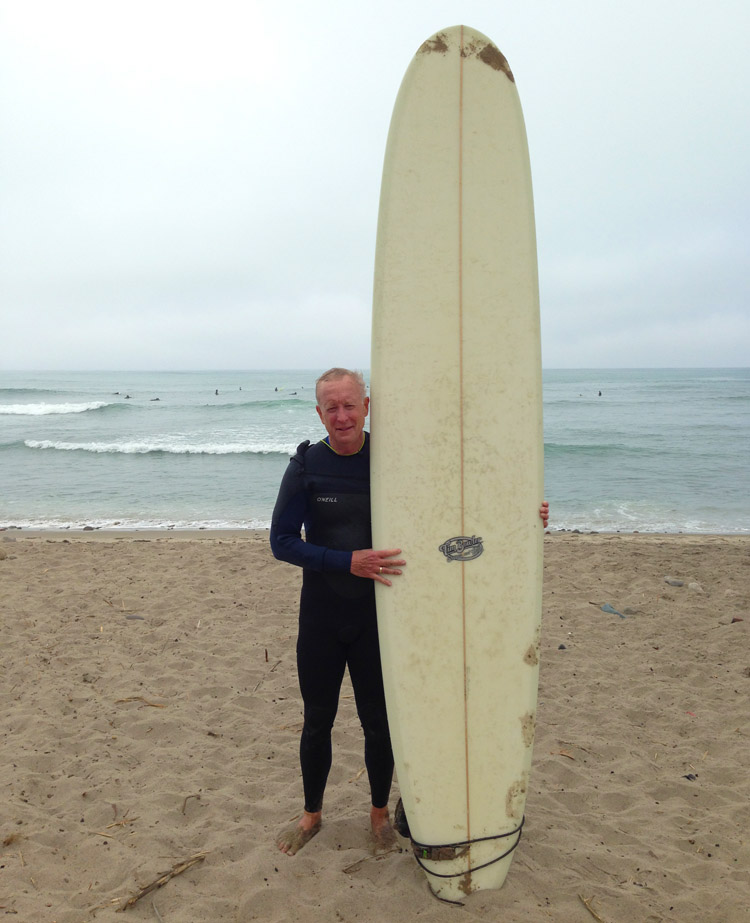
September 2016 | The Shock
Six weeks later, I meet with my surgeon to discuss nerve pain in my left hand. He tells me the arm has to be amputated. I am crushed. It will take three weeks to schedule the surgery.
I am due in Los Angeles for business and a lesson at San Onofre the following week. That will work. My wife and I had a trip scheduled to Honolulu in four weeks, so we scramble to change the hotel and flight dates. It looks like I have some surfing time left.
Alec, from Endless Summer Surf Camp, meets me at Old Man's at San Onofre State Beach. We had been out before on a rough day. I don't think he believes that I ever stood up on a surfboard, and certainly my new one.
We paddle out and sit up. The sun is bright as we look toward the horizon to see what is coming our way. Like magic, the waves have transformed from a SoCal beach break to a Waikiki mellow wave machine, exactly what the rocky bottom at Old Man's can do.
The first wave I catch is blown by trying to stand up all at once. Next wave, I stick it with my low, Island-style stance. Feet glued to the board, stable, I am riding down the line.
When I get back out, Alec tells me it is okay to relax a bit as I do not need to stay in my big wave crouch. Next wave, I am standing relaxed as a longboarder should. I have not forgotten about surgery, but the dread has changed to the next challenge. My mind is right.
October 14, 2016 | Back to Waikiki
There is a saying that the best surfer is the one having the most fun. I'm not the best surfer, but it's hard to have more fun than I had the next week in Honolulu.
It was a great trip; I caught waves for three days at Tonggs on my new board. Even better, on the last day, my friend Ekolu took me to his birthing sands at the Rock Pile, where we slid over to catch a few waves at Ala Moana Bowls.
It is a busy day with what seems like a long paddle. My left arm barely functions, but where else would I want to be or do?
The next morning over breakfast at the Outrigger Canoe Club, I walk to the edge of the water to thank the ocean and Honu, the Hawaiian Green Sea Turtle.
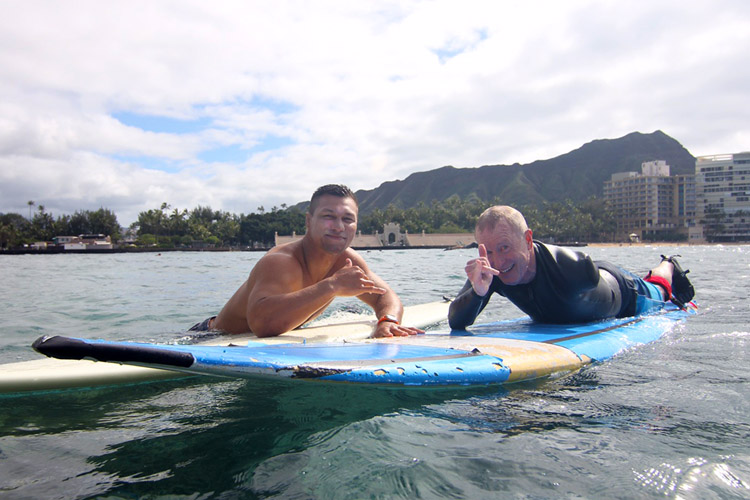
February 2017 | Resuming Surfing Life
Learning to swim with one arm and doing one-arm pop-ups on the pool deck, I am ready to try it again. Lowen Tynanes, a UFC fighter and Hawaiian State wrestling champion, is tasked by Kai Sallas' Pro Surf School to take me out.
In the water with me is my friend John, from LA, who has watched over me almost every time I have surfed in California.
Not knowing what to expect, we start at the beginning with the big board off the Natatorium in Waikiki. First wave, I am up.
Saying "yes" to my friend Bob, I had no idea that I would be introduced to a force that has driven the lives of so many people.
I know I will be back in the water as soon as possible and take what the ocean gives me.
